In recent Eredivisie seasons, Vitesse Arnhem have been a club that have regularly finished in the top half of the table, almost always pushing for European qualification. In fact, the club were in the UEFA Europa League group stages back in the 2018/19 season, while they competed in the UEFA Europa Conference League in the 2021/22 season.
However, this season has been nothing short of a disaster for the Dutch club. Currently, the club sit bottom of the Eredivisie, three points back of the relegation playoff position and seven points from safety. Former Barcelona player Phillip Cocu was in charge at the start of the campaign but resigned in November after only earning eight points in the club’s first twelve matches. Since then, the club have been put in temporary charge of former player Edward Sturing, with the 60-year-old Dutchman not faring much better.
This tactical analysis and scout report will take a deeper look at the main problems that are affecting the Eredivisie side this season, as well as potentially offer some solutions as to how Vitesse could get out of this situation and still be playing top-flight football next season.
Poor box defending and man-marking
One of the main problems that has plagued Vitesse throughout the course of this Eredivisie campaign has been their poor box defending, which has arisen from the constant tendency of the Vitesse defenders to be poor at man-marking inside the penalty area.
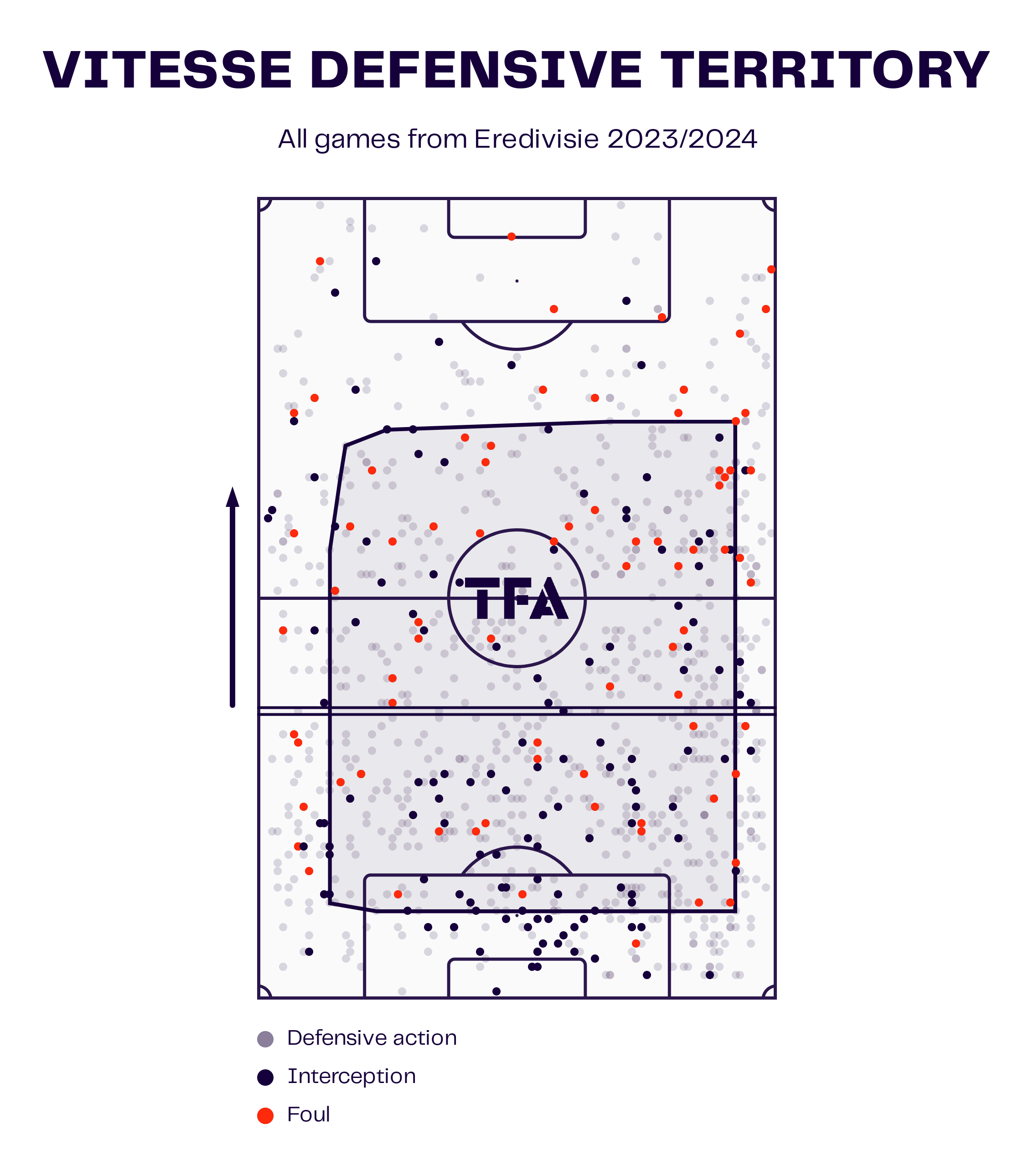
The data viz graphic above shows the defensive territory of Vitesse this season, with this graphic able to give a bit more of a clearer picture of where the Dutch club’s problems lie. As we can see, the average height of Vitesse’s defensive line is inside the middle third of the pitch, with the Dutch side looking to hold a high defensive line.
Most of their defensive deficiencies this season have occurred in the penalty area, with the graphic highlighting the rather lack of defensive actions occurring in this area. This has mainly come down to the poor marking ability of the Vitesse defenders inside this area, with their poor box defending leading to plenty of uncontested shots by opposition attackers.
Looking a bit deeper into the defensive statistics for Vitesse this season, we can start to see the struggles they have dealt with over the course of the campaign. Their 40 goals conceded are the third most in the Eredivisie this season, though their 271 shots against ranks middle of the table defensively.
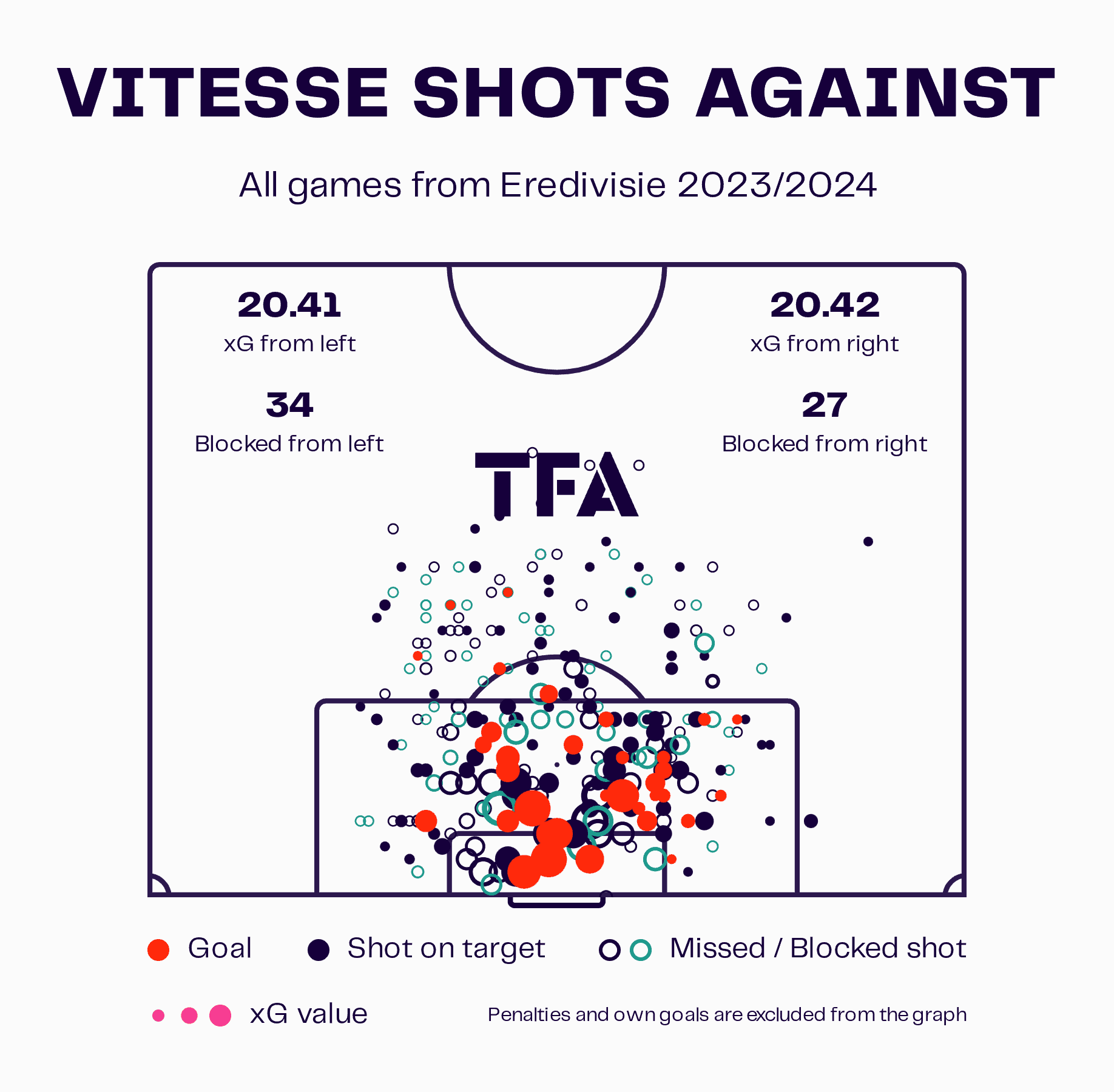
The data viz graphic above shows the shots against map of Vitesse this season, showing the goals and shots they have conceded, as well as from what areas this season. As we can see, the majority of the shots they have conceded have occurred inside the penalty area.
Another problem is that the Vitesse defence commonly does not find themselves in good enough positions to block shots, contributing to the number of saves and shots that 34-year-old goalkeeper Eloy Room has faced this season. Statistically, this season, the Dutch ‘keeper has conceded the third-highest total of goals in the league, with him making the most saves and facing the second-highest number of shots this season.
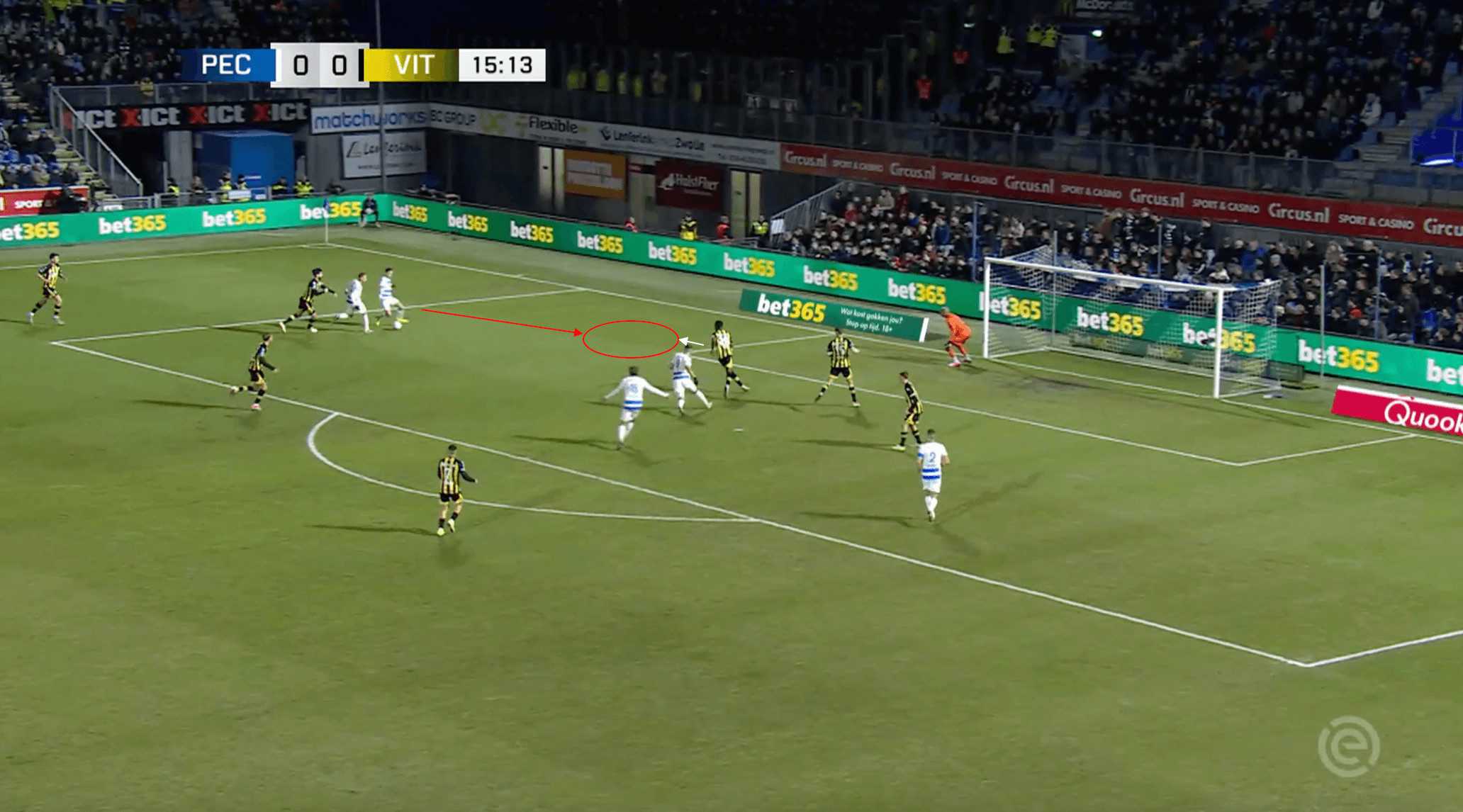
The image above from Vitesse’s most recent Eredivisie match against PEC Zwolle shows an example of the poor box defending and marking from the Dutch side. In this phase of play above, the ball is in possession of the PEC Zwolle wide player, with the attacker initially gathering possession in the wide channel before driving into the penalty box at an angle from the wide area.
The issue arises with the box defending from Vitesse, as can be clearly seen in the example. The centre-back is slow to step out to engage the wide player, allowing him to continue driving into the vacant space towards the edge of the six-yard box. Once the central defender does step out to engage the player, it is already too late, with the opposition attacker able to get his shot off uncontested, with Room being rooted to the spot and PEC Zwolle taking a 1-0 lead that they never gave up.
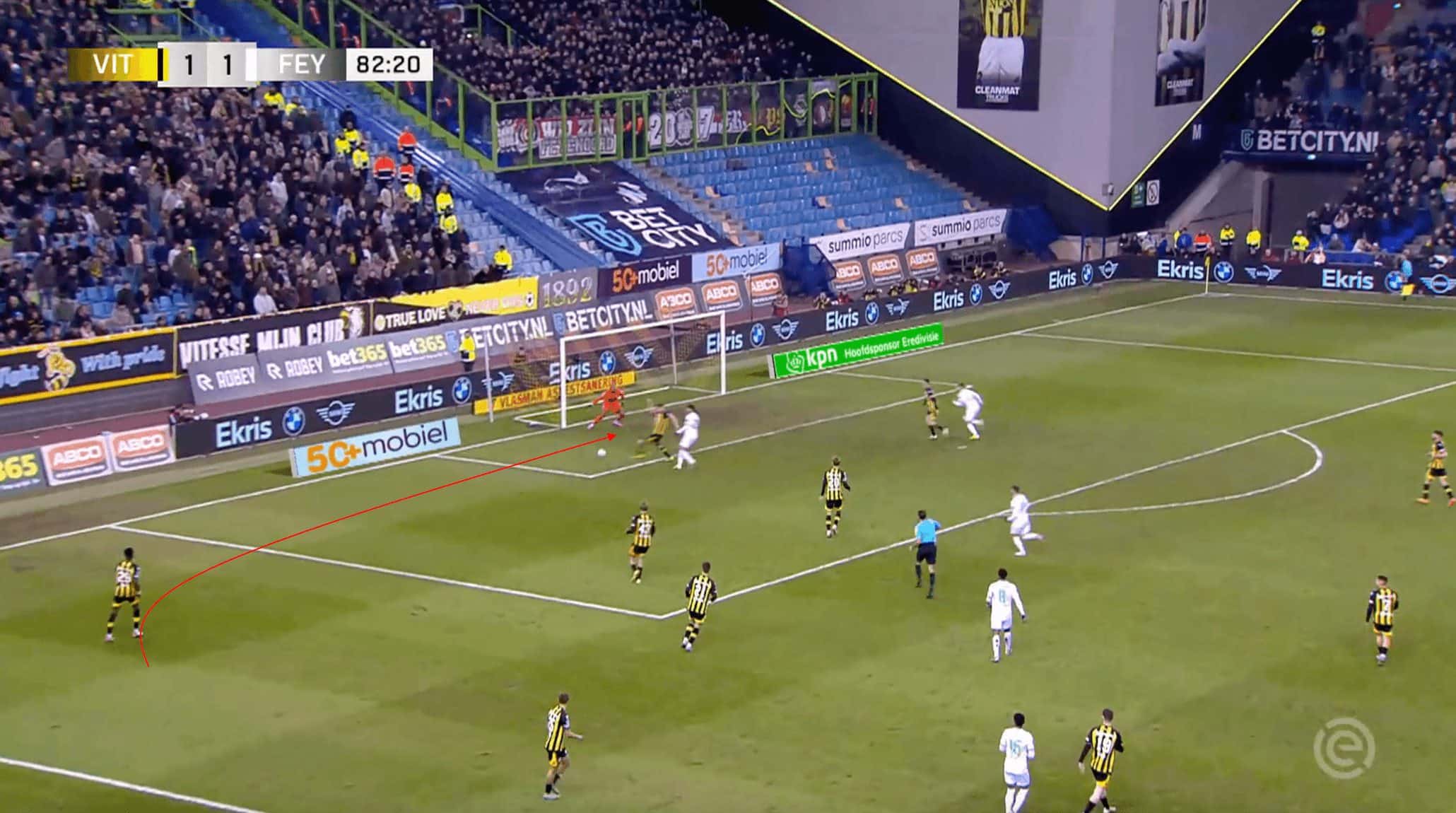
The image above is a two-part example and shows the trouble Vitesse have had when it comes to man-marking inside the penalty area this season. In this phase of play against current champions Feyenoord, the ball was in possession of Brazilian winger Igor Paixão close to the near touchline. The Brazilian was able to send a cross into the penalty area towards two Feyenoord attackers, Mexican striker Santiago Giménez and Czech attacker Ondrej Lingr.
At first glance, Vitesse are in a comfortable defensive position, with both Feyenoord attackers closely marked by the Vitesse defenders and crucially on the goal side of the attackers. There are also other Vitesse players positioning themselves in favourable positions to potentially clear any second balls that may fall towards the edge of the 18-yard box. However, a lapse in concentration defensively is still able to cost the relegation-threatened side.
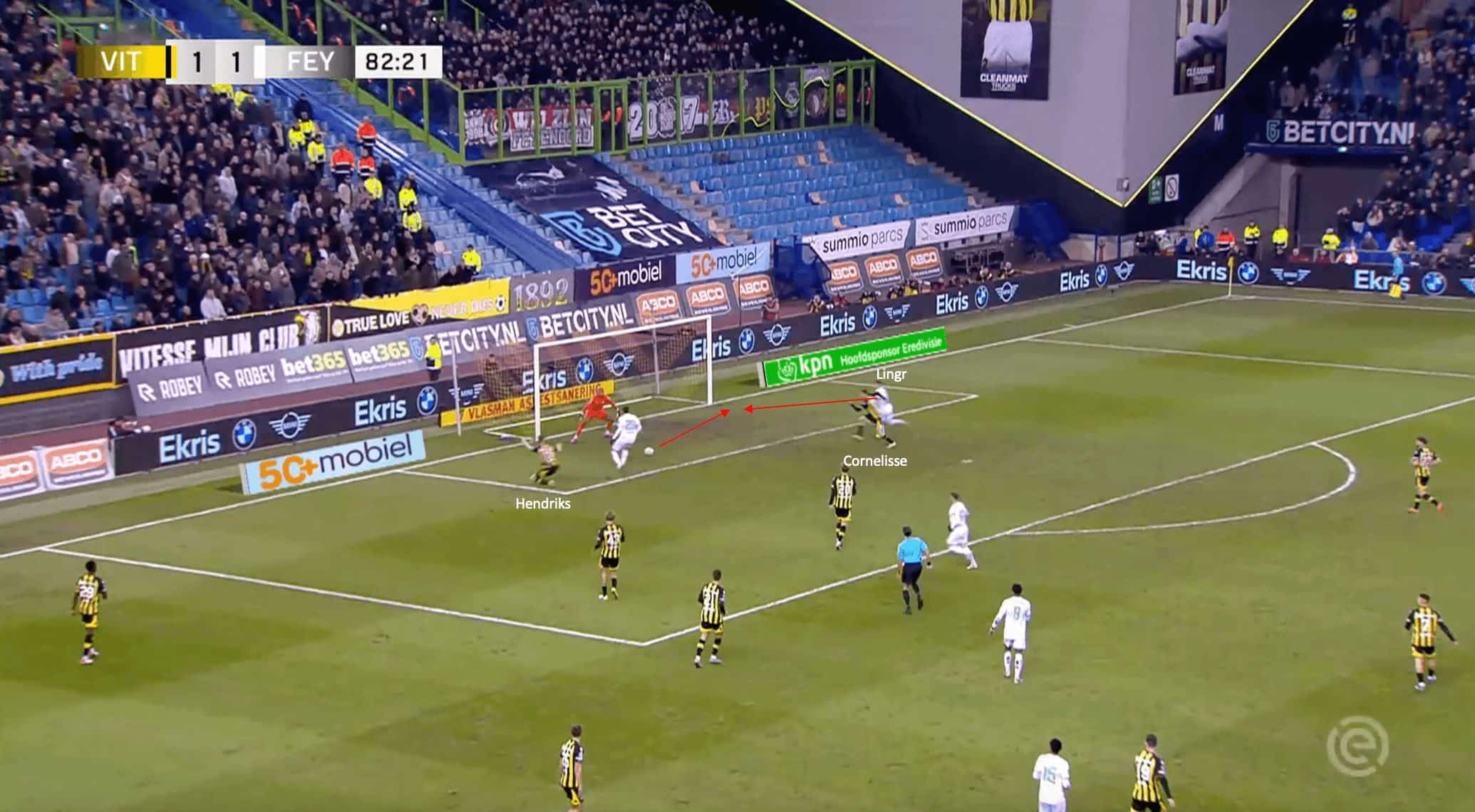
The figure shown above shows what happens as the attacking move for Feyenoord continues to develop. The ball is only deflected and not cleared at the front post area by defender Ramon Hendriks, with the ball continuing to travel towards the back post. Thinking the ball was cleared out of play, left back Enzo Cornelisse slowed down for a split second, with this being enough time for Lingr to get past him and get onto the end of the ball, scoring the winner for Feyenoord.
This lapse in concentration from Cornelisse goes back again to the poor ability to defend in the box from Vitesse this season, with mental errors like this occurring often and defenders constantly switching off at key times defensively.
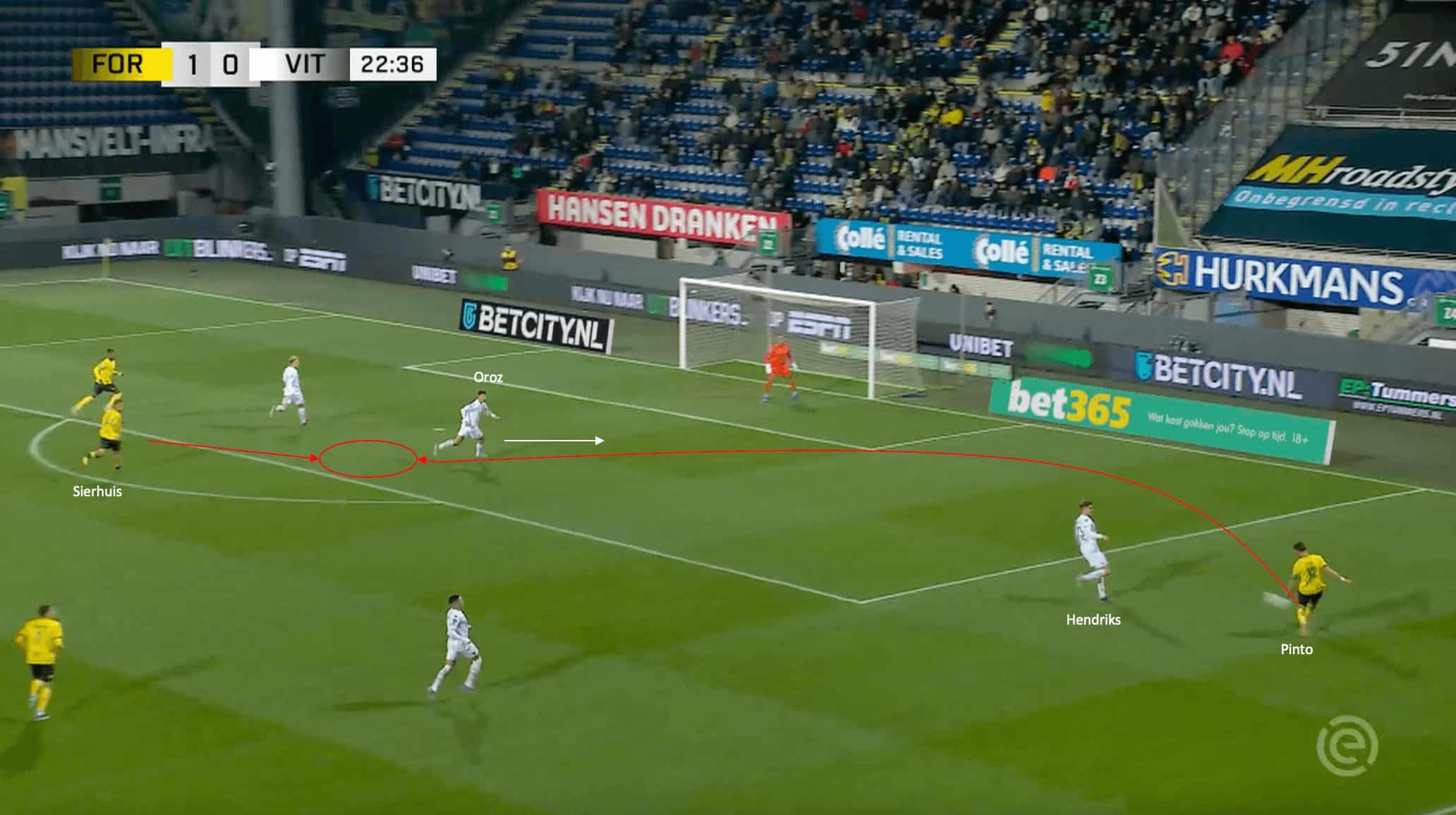
This final example shows another lapse in concentration defensively from the Vitesse defence that leads to a goal for the opposition. In this phase of play against Fortuna Sittard, the ball is in possession of the Fortuna fullback, Ivo Pinto, after making an overlapping run into the final third. To start, Hendriks does not put much pressure on the defender, allowing him to essentially get an uncontested cross sent in towards the edge of the penalty area.
This is now where the defensive lapse and poor marking occurs. As the ball is played into the penalty area towards the penalty spot, centre-back Dominik Oroz continues to mark the space as opposed to stepping out and looking to engage Fortuna striker Kaj Sierhuis, who is making a late run into the box unmarked. Oroz checks over his shoulder and sees the 25-year-old forward coming but decides to continue dropping in to cover the space. As a result, Sierhuis shoots first time as the ball drops to him, again uncontested, giving Eloy Room no chance of saving the shot.
As this section has been able to illustrate, from a defensive standpoint, Vitesse have seriously struggled this season with box defending, with the lapses in concentration and poor marking all encapsulated by this wider problem, one that Edward Sturing needs to fix fast if his side have any chance of avoiding the drop this season.
Poor chance creation ability
It is not just defensively where Vitesse have been struggling this season; arguably, their attack has been worse. In fact, the Dutch side have scored the fewest goals in the league this season, with 13. Waalwijk, currently occupying the relegation playoff place, have the second-fewest with 18. When looking at some more attacking stats, the reading gets worse for Vitesse fans. The club’s 197 shots are the second-fewest in the Eredivisie, with their 266 touches in the penalty area also the second-fewest.
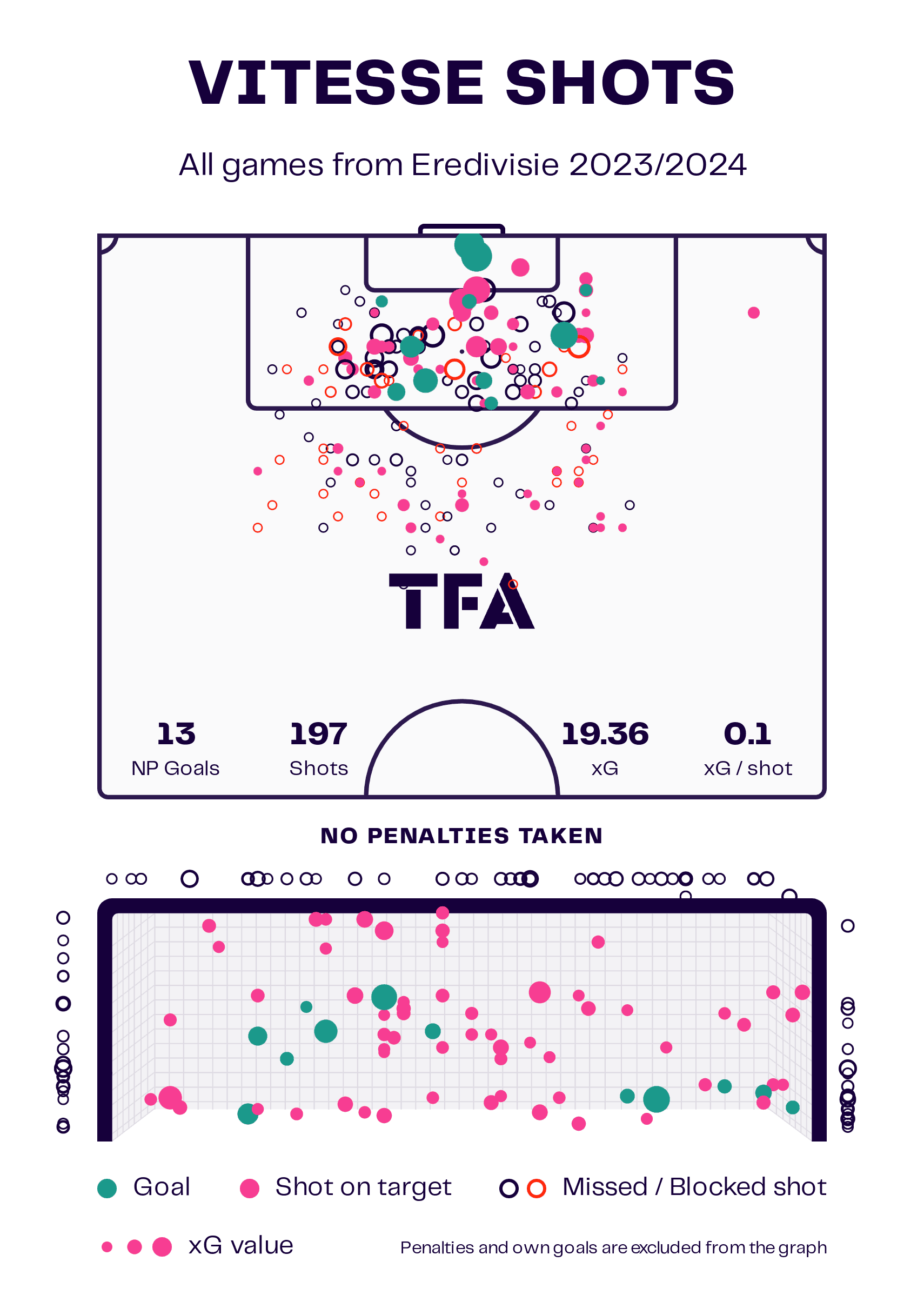
The data viz graphic above shows the shot map from Vitesse this season, putting more into perspective the struggle they have experienced in front of goal this season. The Dutch side have had to attempt a large amount of shots from outside of the penalty area this season, mainly due to Vitesse’s lack of chance creation this campaign. Sturing’s side’s 50 key passes this season is the second lowest in the Eredivisie, highlighting their inability to create chances.
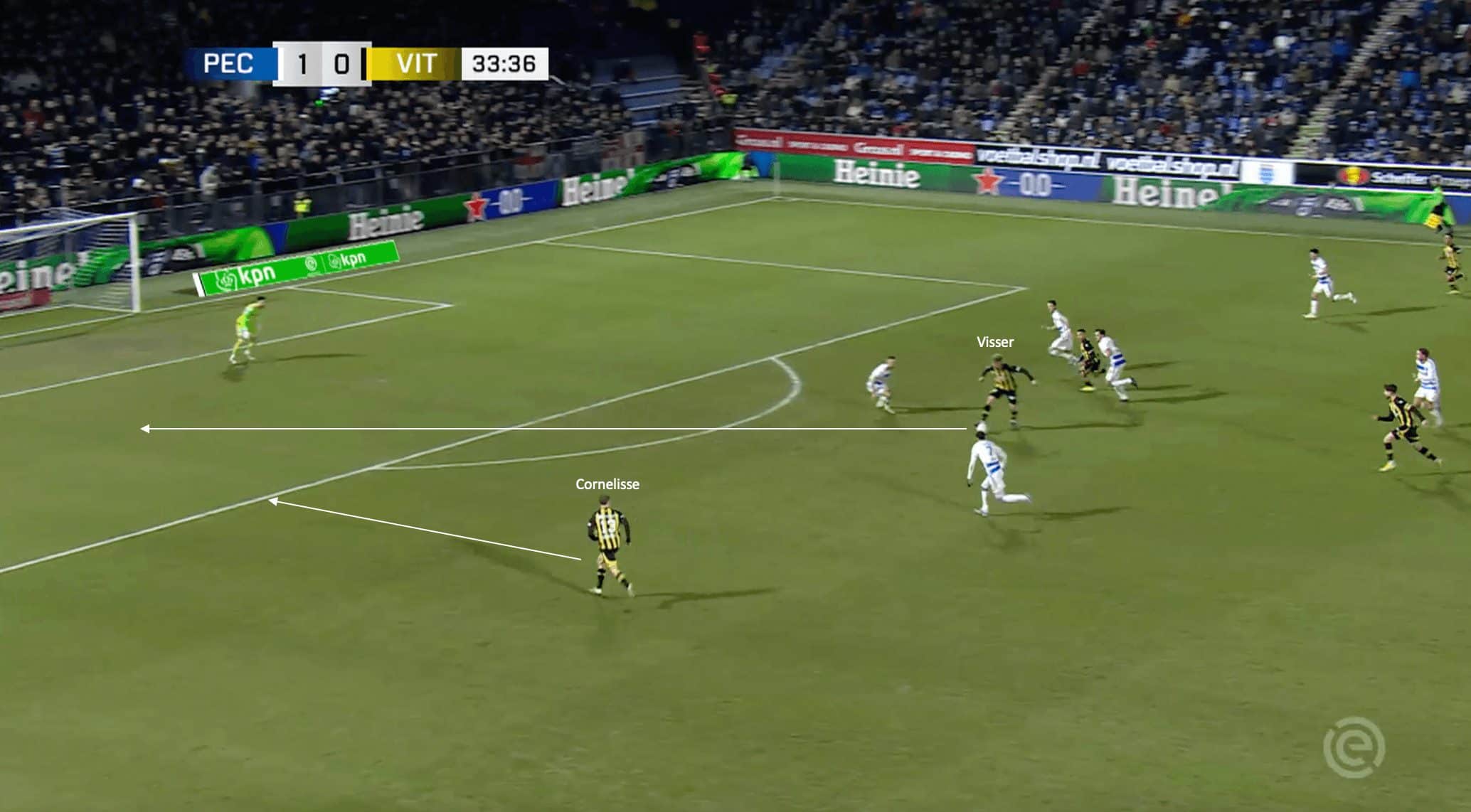
The figure above shows an example of the poor chance creation and inability to play the final pass has hurt Vitesse from an attacking and goalscoring perspective this season. In this phase of play above against PEC Zwolle, the ball is in possession of the striker, Andy Visser. The 19-year-old has his back to goal but is not under immediate pressure, allowing him enough time to turn and spot the run of Enzo Cornelisse’s unmarked running beyond the opposition defence.
All Visser needed was a slightly hit ball into the path of the fullback, which would have allowed him to run onto the end of the pass, cut inside, and potentially attempt a shot on goal. Instead, Visser overhits his pass, with the pass forcing Cornelisse wide and towards the endline. As a result, the chance to either shoot first time goes away, forcing the defender to attempt an off-balance cross towards the back post area. Ultimately, the ball ends up in the goalkeeper’s hands, eliminating any possible goalscoring opportunity.
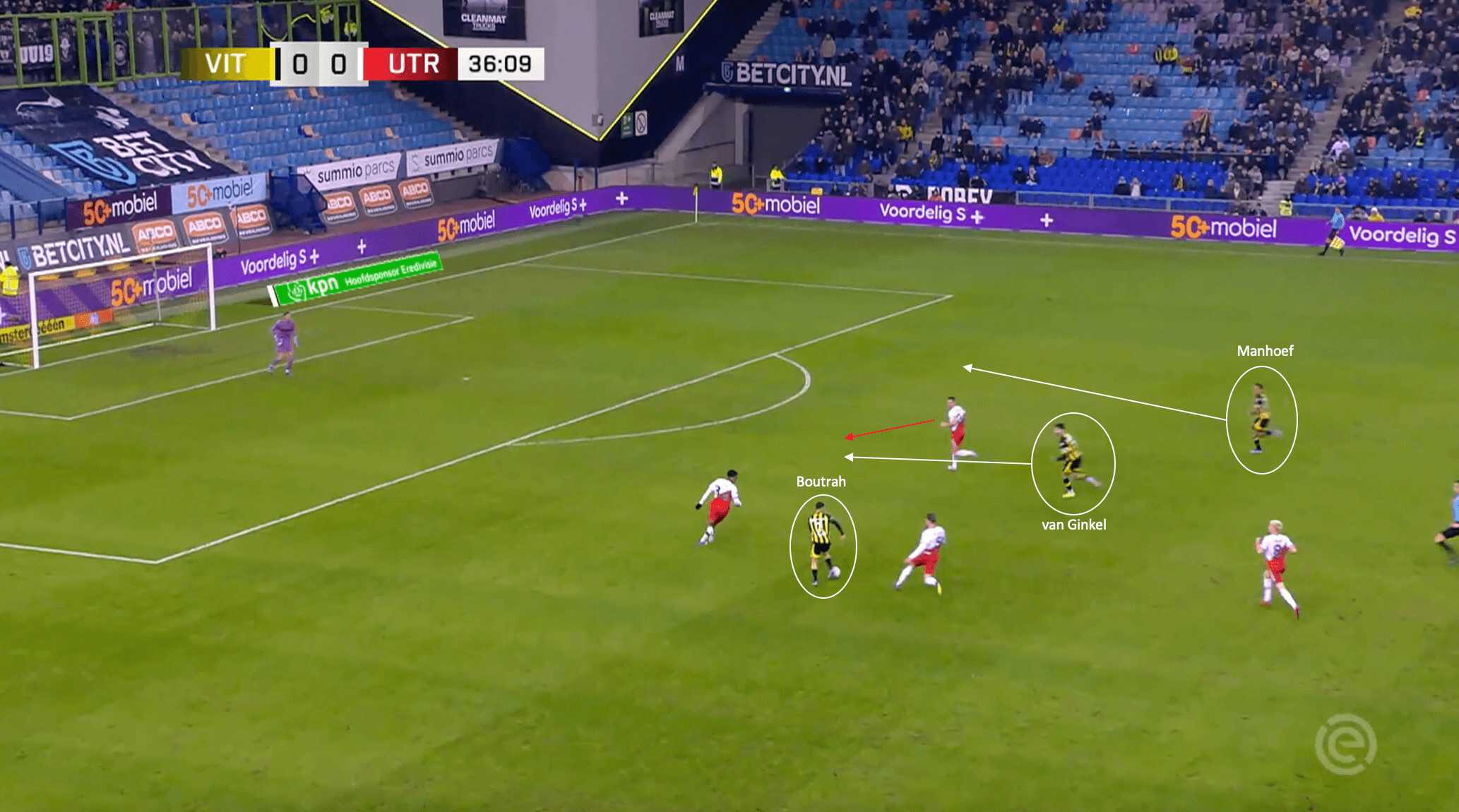
The image above shows another example of the lack of quality that Vitesse have displayed when it comes to trying to play the final ball to create a chance on goal. In this phase of play above against Utrecht, Vitesse are on a quick counterattacking sequence, with the Dutch side holding a 3v2 advantage against the Utrecht defenders. There is also very good movement to both create space and open a passing lane for Amine Boutrah. Club captain and former Chelsea midfielder Marco van Ginkel makes a run from deep, looking to split the two centre-backs, with this run dragging the left central defender towards his run, freeing up Million Manhoef in the back post area.
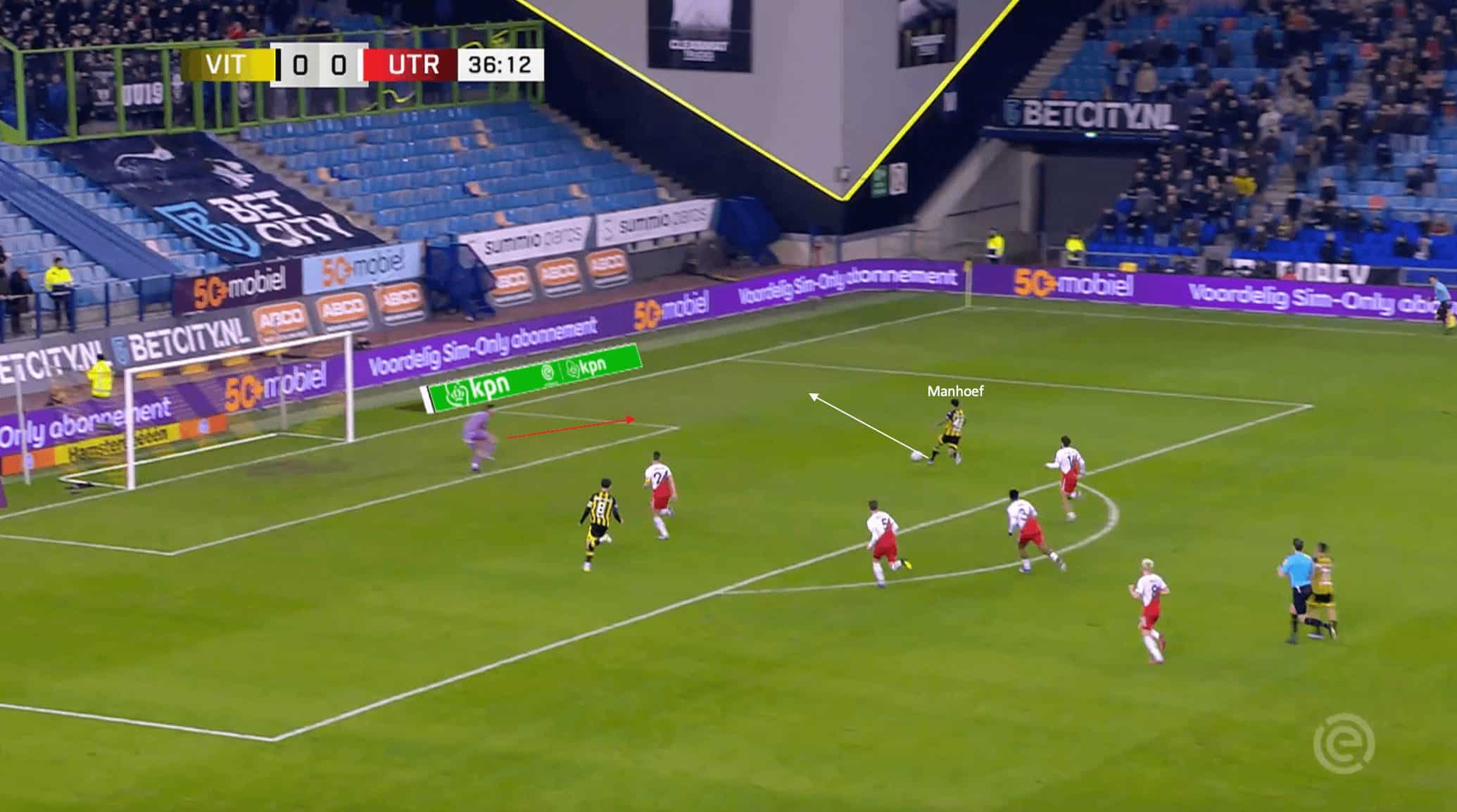
The figure above shows how this attacking phase ends for Vitesse, with all the very good off-the-ball movement and space creation essentially being wasted. The final pass from Boutrah to find Manhoef in the space was overhit, forcing the young striker to drift wide towards the edge of the penalty area to get onto the end of the pass. As a result, this allows the Utrecht goalkeeper to come off his line and close the angle for Manhoef, making it almost impossible for him to squeeze the ball in at the near post area.
Also, there is no support for the striker to look to find, with only van Ginkel continuing his run into the penalty area to support. Meanwhile, the rest of the Utrecht defence is able to sprint back and get into defensive positions. As a result, Manhoef’s ensuing shot was weak and right at the goalkeeper, meaning another big chance went begging for the Dutch side that could have given them a very important lead in a match that ended up finishing 0-0.
As this section has been able to illustrate, the attacking side of the game from Vitesse has also been a mighty struggle for the Dutch side this season, with the attacking woes not being fixed since the appointment of Sturing almost three months ago. If the Dutch coach is able to get his attacking players more clinical with their passing in the final third and ability under pressure in these situations, it could go a long way to Vitesse finally scoring more goals that may be able to save them from relegation come the end of the current campaign.
Conclusion
As this tactical analysis and tactics piece has shown, Vitesse are in a lot of trouble as the business end of the Eredivisie season approaches. With the club sitting at the bottom of the table and seven points from safety, a lot needs to be done to ensure they are not relegated.





Comments